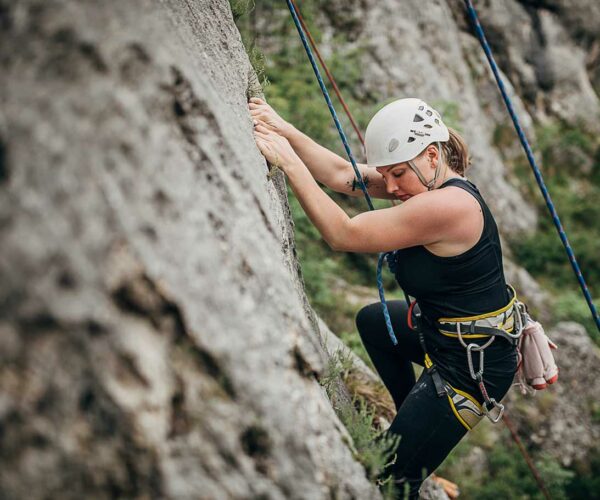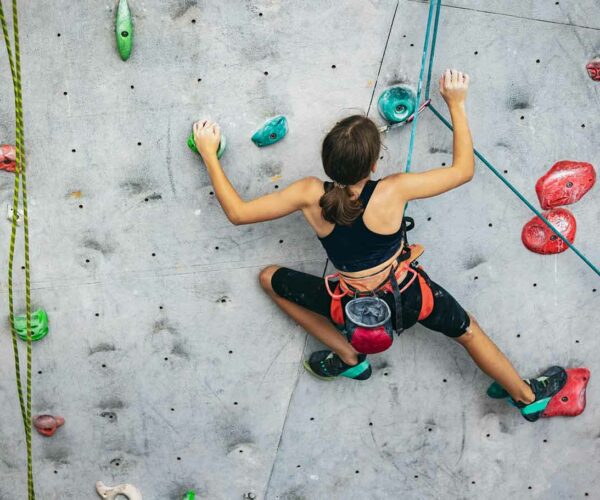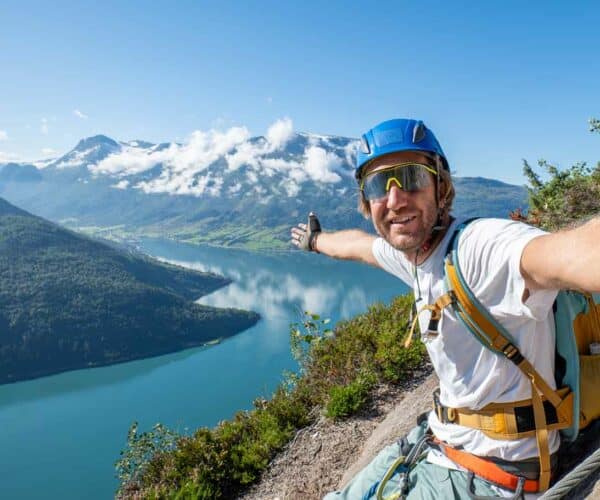Rock climbing, whether you’re scaling an indoor wall or tackling a rugged outdoor cliff, offers a thrilling mix of physical challenge and mental puzzle-solving. But if you’re a climber (or a wannabe climber) you’ve probably found yourself wondering: Is indoor or outdoor rock climbing better? Which is harder? And, most importantly, which is the right choice for you?
Whether you’re a die-hard gym climber or a nature-loving cragger, both indoor and outdoor climbing have their own unique appeals. Indoor climbing is perfect for those looking for convenience, community, and a controlled environment to hone their skills. Outdoor climbing, on the other hand, offers adventure, unpredictability, and the joy of climbing in some of the most beautiful landscapes the UK has to offer.
Different Types of Climbing

Let’s take a quick tour through the different types of climbing, from bouldering to mountaineering, to see which one really takes the cake in terms of difficulty.
Bouldering
Short, intense routes that pack a punch in a small space. It’s all about power and technique, with no ropes or harnesses—just you, your shoes, and your chalk bag. Bouldering problems are often the most physically demanding on a move-by-move basis, but you don’t have to worry about the endurance needed for longer climbs.
Sport Climbing
This involves longer routes with pre-placed bolts for protection. It’s a mix of endurance and technique, requiring you to keep climbing even when your arms start screaming. Sport climbing can be less mentally taxing than traditional climbing because the protection is already in place, but the physical challenge is significant.
Traditional (Trad) Climbing
Now we’re getting into the big leagues. In trad climbing, you place your own protection as you go, which means you need a sharp mind and a cool head. It’s not just about climbing the route—it’s about making sure you’re safe while doing it. The mental challenge of trad climbing, combined with the physical demands, makes it one of the most difficult forms of climbing.
Alpine/Mountaineering
This is the ultimate test of endurance, skill, and mental fortitude. Alpine climbing involves long routes, often at high altitudes, with the added challenges of weather, navigation, and the need to carry all your gear. It’s a full-on adventure that tests every aspect of your climbing ability.
Understanding the basics of Indoor and Outdoor Climbing

What Is Indoor Climbing?
Indoor climbing, as the name suggests, takes place in purpose-built facilities where the weather is always perfect, the coffee is within arm’s reach, and the routes are designed to challenge and entertain. Think of it as a giant, colourful playground for climbers of all levels.
Indoor walls are packed with artificial holds and routes, or “problems” (if you’re bouldering), that vary in difficulty. These routes are carefully set by experienced climbers to test your skills in different ways—whether that’s endurance, technique, or sheer willpower. The best part? You can climb indoors all year round, rain or shine. Plus, it’s a social hub where you can meet other climbers, swap stories, and maybe even pick up some tips and tricks.
But let’s not forget the hidden gem of indoor climbing: the convenience. No need to check the weather, pack all your gear, or worry about whether your chosen crag is busy. You can simply show up, tie in, and start climbing.
What Is Outdoor Climbing?
Outdoor climbing, on the other hand, is where the wild things are. Literally. You’re out in nature, scaling cliffs, boulders, or mountains, with nothing but your skills, your gear, and the occasional sheep for company. It’s the real deal—no colour-coded holds, no controlled environment, just you and the rock.
Outdoor climbing is all about adapting to the natural environment. The routes aren’t set by humans but by millions of years of geological processes, meaning you’ll encounter all sorts of rock textures, shapes, and sizes. It’s unpredictable, challenging, and absolutely exhilarating. And let’s face it—there’s something incredibly satisfying about conquering a natural rock face with the wind in your hair and the sun on your back (or, more realistically in the UK, a slight drizzle).
The great outdoors also offers a sense of adventure and connection with nature that you simply can’t replicate indoors. Every crag has its own character, every route its own story.
Is Indoor or Outdoor Bouldering Harder?

So, you’ve got your shoes chalked up and your crash pad ready. Now the big question: Is indoor or outdoor bouldering tougher? The answer, as you might expect, isn’t straightforward—it’s like comparing apples to oranges. Or rather, comparing a perfectly polished apple to one still hanging on the tree in a howling gale.
Indoor Bouldering
Imagine you’re in your favourite climbing gym. The holds are clean, the routes are meticulously graded, and the floor is padded. Indoor bouldering is all about precision and technique. You can try the same problem over and over until you nail it, with no surprises (unless the route setter was feeling particularly devious).
It’s a controlled environment, so you can focus purely on your climbing. The challenges are often mental—solving the “puzzle” of each route—and physical, as you push your body to master tricky moves.
Outdoor Bouldering
Now picture yourself at a popular outdoor bouldering spot. The rock is rough, the holds aren’t always obvious, and the landing zone might be less forgiving. Outdoor bouldering is a whole different beast. The natural environment means that every problem is unique, with real rock offering more complex and unpredictable challenges.
You might find yourself battling not just the rock but also the elements—wind, rain, and even the occasional inquisitive sheep. The added factors of finding the best landing spot for your crash pad and spotting yourself or your climbing partner all contribute to the intensity of the experience.
Factors Influencing Difficulty
So, which is harder? The truth is it depends. Indoors, you might face more technically difficult problems because of the controlled environment. Outdoors, the difficulty comes from the variability—holds can be tiny, sharp, or far apart, and conditions might change on a whim.
Grading systems differ too. Indoors, grades are more consistent, whereas outdoor grades can vary depending on who set them and when. Some climbers find outdoor bouldering harder because of the additional mental challenge of dealing with the natural environment. But others thrive on the unpredictability and find the controlled setting of indoor gyms to be less thrilling.
Ultimately, it comes down to personal preference. Are you a methodical climber who enjoys problem-solving in a controlled environment? Or do you thrive on the adventure and unpredictability of the great outdoors?
Comparing Indoor or Outdoor Climbing

Popularity and Accessibility
When it comes to where people are climbing, indoor walls have seen a huge surge in popularity in the UK. Indoor climbing gyms are popping up everywhere, offering a fantastic way to get into the sport or keep training year-round. The convenience of indoor gyms makes them a great choice for urban dwellers or those just starting out. You don’t need much gear—just shoes, chalk, and maybe a harness—and you’re good to go. Plus, with the rise of competitive indoor climbing and events, there’s a strong community vibe that’s hard to beat.
Outdoor climbing, though, remains the ultimate goal for many climbers. After all, climbing was born outside, on real rock, under the open sky. Transitioning from indoor to outdoor climbing is a rite of passage, offering new challenges and experiences. In the UK, we’re spoiled for choice with world-class outdoor climbing spots like the Peak District, Lake District, and Scotland’s Highlands.
But while outdoor climbing is incredibly rewarding, it does require more preparation. You need to consider the weather, plan your routes, and carry more gear. It’s not as simple as walking into a gym, but the rewards—a sense of accomplishment, breathtaking views, and the sheer joy of climbing in nature—are well worth the effort.
Experience and Skill Development
Indoor climbing is fantastic for building specific skills. You can focus on improving your technique, working on your endurance, or nailing that one tricky move you’ve been struggling with. The consistency and controlled environment allow for repeated practice, making it easier to track your progress.
Outdoor climbing, on the other hand, is where you really test those skills. Climbing outside requires you to adapt to the rock, make quick decisions, and often climb routes that are physically and mentally tougher. It’s not just about climbing the route—it’s about reading the rock, planning your moves, and sometimes dealing with the unexpected, like a sudden change in weather or a tricky section of the route that wasn’t obvious from the ground.
Many climbers find that a mix of indoor and outdoor climbing offers the best of both worlds. You can build your strength and skills indoors, then apply them to the unpredictable, and often more challenging, outdoor environment.
Is Scotland good for surfing?
Scotland is an exceptional destination for surfing, offering a unique blend of stunning landscapes, powerful waves, and a vibrant surf culture. The country hosts several prestigious competitions and events, such as the Scottish National Surfing Championships and the Tiree Wave Classic, attracting surfers from around the globe.
The west and north coasts are famous for big waves, with spots like Thurso East and the Isle of Lewis delivering formidable swells that challenge even the most experienced surfers.
Accessibility is also a strong point, with numerous surf schools and clubs providing lessons and equipment hire, making it easy for beginners to get started. Whether you’re chasing big waves or just starting, Scotland’s diverse surf scene has something to offer every enthusiast.
What is the most difficult type of climbing?

What makes climbing hard?
So, what exactly makes climbing difficult? It’s a mix of physical demands—like strength, flexibility, and endurance—and mental challenges, such as fear management, problem-solving, and focus. Throw in environmental factors like weather, altitude, and rock type, and you’ve got a sport that’s as demanding mentally as it is physically.
Which Is the most difficult?
If we had to crown one type of climbing as the hardest, many would argue that traditional climbing and alpine climbing top the list. The need to place your own protection, the length and complexity of the routes, and the environmental factors make these forms of climbing particularly challenging. But remember, difficulty is subjective. Some climbers might find a short, powerful bouldering problem harder than a long trad route, depending on their strengths and weaknesses.
Indoor vs Outdoor: Which Is Right for You?
Assessing Your Goals and Preferences
So, which should you choose—indoor or outdoor climbing? The answer depends on what you’re looking for.
If your goal is to improve specific climbing skills, enjoy a social atmosphere, or simply get a good workout, indoor climbing might be your best bet. It’s convenient, varied, and you can easily track your progress.
But if you crave adventure, love being in nature, and want to test yourself against the unpredictable, then outdoor climbing is where it’s at. There’s nothing quite like the feeling of topping out on a real rock face after a challenging climb, with nothing but the open air and stunning views around you.
Tips for Balancing Both
So, why not give both a try? You might find that you enjoy the different challenges and rewards each has to offer. And at the end of the day, climbing is climbing—whether you’re inside or out, it’s all about pushing your limits, having fun, and maybe sharing a laugh or two with your fellow climbers.
Get Climbing Insurance with SportsCover Direct
Having the right protection is essential when it comes to indulging in high-octane activities such as climbing. After all, there’s a certain level of risk involved, which is all part of the excitement. However, you don’t want to be left out of pocket if something does happen; this is why taking out a reliable climbing insurance policy is essential.
SportsCover Direct’s Climbing Insurance offers specialist cover for up to 7,000m. Choose from travel insurance to protect you in the event of unforeseen expenses while overseas, whether you’re rock climbing competitively or just for leisure. If your plans change through no fault of your own, or you’re suddenly hit with medical costs, this policy will lessen the financial impact.
Alternatively, choose a sports accidents policy, giving you personal liability and income protection for incidents that occur in the UK.
Get a personalised quote now and confirm your new insurance in minutes. If you’ve any questions at all, just get in touch with our team.
This blog has been created as general information and should not be taken as advice. Make sure you have the correct level of insurance for your requirements and always review policy documentation.